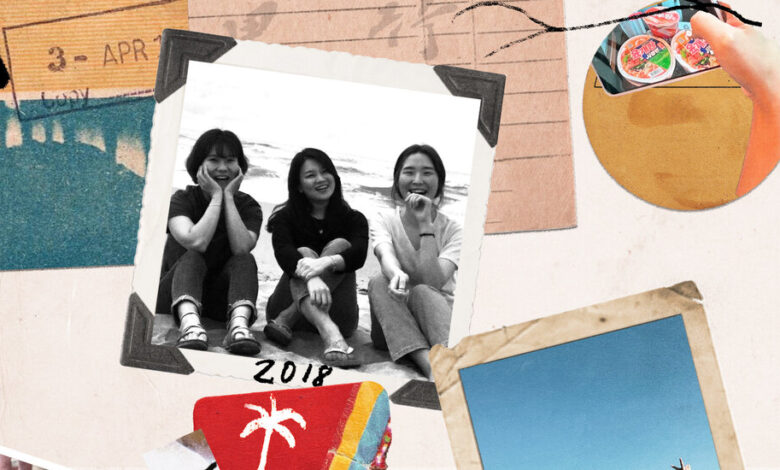A Korean Secret to Keeping Friendships Strong: Savings Groups

Last fall, Jina Kim and two of her friends splurged on a two-night stay at the Ananti at Busan Cove, a luxury resort in Busan, South Korea.
The resort, where rooms start at $369 a night, features infinity pools, spas, eight restaurants, a private coastal walk and beach area, and a 4,600-meter “Water House” — an indoor pool and sauna fed by natural hot-spring water.
“We just spent the whole day in the resort hotel, swimming, eating and drinking,” said Ms. Kim, a 32-year-old former teacher who is now a stay-at-home mother.
Ms. Kim and her friends weren’t worried about how they would pay for the trip because they had spent over a decade saving in a “gyemoim,” a Korean term for people who form financial planning groups to save money for future expenses.
Forming gyemoim groups can help friends or families split travel costs equally so everyone can participate, regardless of his or her personal budget.
“Honestly, if we didn’t make the gyemoim, then it would have been too difficult for us to arrange that kind of trip,” Ms. Kim said. “It would have cost too much, and we didn’t want other members to feel pressured by that.”
Maintaining Relationships Through Saving
Collective financial planning has had a long history in many parts of the world.
“It’s actually not unique to South Korea,” said Euncheol Shin, an associate professor of economics at KAIST College of Business in Seoul. “This practice first developed because there was no financial market out there, and if you wanted to borrow some money, you had to do some self-financing.”
Dr. Shin gave an example of a village 200 years ago that needed to buy seeds to grow rice. The financial structures to take out loans didn’t yet exist in many places, so villages pooled their money, bought supplies and split what they reaped.
Over time, this practice evolved into a way for people to keep friendships strong and communities united.
Each member of a gyemoim contributes what are essentially “club dues” — often between $10 and $50 each month, with the amount decided by the group. As the balance increases, the members discuss how to spend it together.
Ms. Kim first formed a gyemoim with two friends after they met at a social club in 2014. The three were attending different colleges and believed the gyemoim would allow them to regularly meet up.
Initially, they each agreed to contribute 15,000 won, or about $13, every month. Over the next decade, they saved more than 3,000,000 won, or about $2,200, before deciding to spend the money on a trip to the Ananti, the resort. By then, the three friends had become busy with their own careers and families, but they remained close, in part, because of the gyemoim.
“It allowed us to keep in touch and have a good time together without worrying about the cost,” Ms. Kim said.
Young-hoon Lee, 35, said his mother headed the gyemoim for her apartment building.
Mr. Lee, a teaching assistant at an English language academy, is part of a gyemoim that consists of two women and four men, all of whom contribute 50,000 Korean won, or about $36, each month.
“We became close friends during high school, and we’ve remained friends into adulthood,” he said. “Initially, we got together just to have fun, but as everyone started working, we began thinking more about the future. So, while maintaining our friendship is important, we also decided to support each other through significant life events, such as weddings or funerals.”
Mr. Lee’s gyemoim typically uses its shared funds to reconnect a handful of times a year, usually to enjoy a meal of Korean barbecue or fried chicken and beer.
Ms. Kim also traveled with a different gyemoim to Vietnam at the end of April. The trip cost much less than her stay at the Ananti, though she said her group of three women still stayed in a nice hotel and had a great time together.
Why Gyemoims Work in South Korea
Gyemoim groups can work in South Korea because of the nature of the country’s social interactions and culture of trust.
For example, in South Korea you could walk into a coffee shop in Seoul and leave your bag, laptop and wallet full of credit cards and cash at your seat unattended and go to the bathroom without needing to worry if it would all be there when you got back.
“Let’s say that you and I are friends,” Dr. Shin said. “We have grown up in a small town for a very long time. We know everything about each other. If I borrow some money and I don’t pay it back, then you’re going to say, ‘Hey, everyone, Euncheol borrowed some money from me, and he never paid me back.’” Because of the collective nature of social groups, Dr. Shin explained, he would be ostracized by people in his community.
Forming a group to save is so common in South Korea that one bank is adapting to the custom. KakaoBank, an arm of the country’s most popular communication app, KakaoTalk, now offers a gyemoim group account product where friends can share a bank account managed by one designated account holder.
Mr. Lee and Ms. Kim started their gyemoim groups before KakaoBank existed, so they entrusted their funds to one member of their saving circles. Some groups, like Mr. Lee’s, still prefer this “old-fashioned” method of collecting money. Mr. Lee said one of his groups had decided who would be entrusted with the money by majority vote.
Both of Ms. Kim’s gyemoim groups now use the KakaoBank option because it allows all members to see how their pooled money is moved in their account, which earns up to 2 percent interest. The account manager is the sole person with control over how the funds are used, but everyone pays in. Users can set reminders to send their monthly dues to the account and communicate through the app’s chat feature.
Gyemoim groups don’t last forever. Circumstances change, friends may have a falling-out, someone may no longer want to participate or a new person may want to join. When that happens, it’s up to the collective to decide how to handle it.
“There are no particular rules to run a group, although in some groups, other people have created their own rules,” Ms. Kim said. “But my groups never really had rules.”
Ms. Kim’s gyemoim that visited Busan used to include another friend, who decided to bow out a few years ago for financial reasons.
“In our case,” she said, “we asked her what she wanted to do with her part of the money. She decided to have her part refunded instead of using it. ”
While there was a peaceful parting of ways in Ms. Kim’s gyemoim, disagreements aren’t unheard-of, either. Ms. Kim said she had a friend who was part of a gyemoim that disbanded when its members couldn’t agree on how to plan a trip. For a group to be successful, she added, members need to share similar interests and values.
Could Gyemoim Groups Work in the U.S.?
No American bank offers a product quite like what South Korea’s KakaoBank offers for gyemoim groups. To ensure full transparency for all members of your group, the closest option is to open a joint checking or savings account so those involved can have equal access.
This could be difficult depending on the size of your group and your proximity to one another. Banks that don’t have traditional brick-and-mortar locations are most likely going to have the best options. For example, a representative from Ally Bank, which operates online, said the bank allowed up to four co-owners on a spending account.
If you open an account with a bank that includes fees, factor the cost into everyone’s shared contribution.
Opening a joint account has drawbacks, too, such as what might happen if a friend wants to leave the group. Depending on the bank, removing someone from a joint account can be tough or impossible without closing the account.
In addition, unlike an individual account, a joint account gives every person equal legal ownership of the funds in it whether the person contributed all of the money or not. Despite shared ownership, you can’t force anyone to pay dues into the account, either.
Still, if you wanted to form a gyemoim, you could do it the old-fashioned way by selecting one trusted person to be in charge of pooled funds in an individual savings account.
The cultural traditions that allow gyemoims to work well in Korean society aren’t as present in Western culture, so collective funding can be a bit of a gamble if you don’t know your members well.
When forming a group, Mr. Lee suggested, include at least “one or two trustworthy people.” He also recommended the group stay open to new members, as circumstances can change unexpectedly, and new friends can energize a group that has grown stale.
Mr. Lee also recommended forming groups around a specific purpose, such as getting together regularly to pursue a hobby. Friends who have known one another a long time, such as Ms. Kim and her friends, may easily save money with no concrete purpose in mind. But new friends or acquaintances will thrive if they have mutual interests.
“As a Korean who values a sense of community, I think the culture of community is good, and I hope more people will pursue a culture where everyone gets along well,” Mr. Lee said.



